|
|
|
|
| All of this extra writing is wasted if you do not know it is there. So please take a moment to read Please Read this First it is a mouse over that will disappear as soon as you move the mouse off the text |
| Some of the text is in Italic. That is a fair sign that the word has one of these boxes trying to explain or inform you of something |
|
Those slanted letters . You have reached the deepest <Div> Kinda disapointing isn't it! I'll have to do something about that Any suggestions |
| This page is made for Internet explorer 5.5 and has some features that will just work with it like these <div> boxes or the color bar to name two out of three. |
| Menu |
| HIDE BOX | I give you the ability to change the color of thing around here Legal | ||||||||||||||||||||||||||||||||||||||||||||||||||||||||||||||||||||
| Visited_Link | |||||||||||||||||||||||||||||||||||||||||||||||||||||||||||||||||||||
| Link color | |||||||||||||||||||||||||||||||||||||||||||||||||||||||||||||||||||||
| Background | |||||||||||||||||||||||||||||||||||||||||||||||||||||||||||||||||||||
| Text_Color | |||||||||||||||||||||||||||||||||||||||||||||||||||||||||||||||||||||
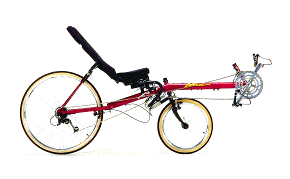
|
This Page takes a long time to load ,but if you are looking for a semi objective view on recumbents it is worth the wait.
It page has gotten a temporary reprieve here at Geocities PLEASE VISIT THEIR ADD Things change. This Page will always be under construction. I welcome any critisim you want to give! I am not happy with this page and need some feed back from you the reader. |
||||||||||||||
| ||||||||||||||
| This page is always under construction. Any Suggestions |
| a link to this page
This is my description of making a fairing. I think that this is not a very good
description of how fairings can be made
|
| a link off page to
What IS a Zzipper?
The clear objects in this picture are zipper fairings. A clear, lightweight wind screen made of shatter-proof Lexan (GE) Poly carbonate Plastic -- The same material used in armored cars and drive-up tellers. The strong lightweight mounting system consists of various lightweight, anodized aluminum systems. Easy to remove, the Zzipper fairing actually rolls up for ease of transport.
|
|

|

|
| Commercial “skirt” from zipper | Same type bike without the “skirt” |
| a link to this page
This is a link to further in this page
describing how I made my fender covers
|
| a link to this page
|
| The pictures are all from the same family of bikes from Vision by Alternative Transportation. http://www.visionrecumbents.com/
These are a few of the bikes they make. | ||||

|
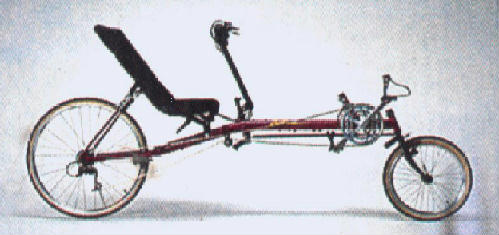 |
|
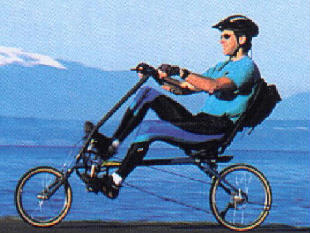 |
|
| A R40/42 | Another R40/42 | Mine is a R40 | Their CLWB bike | |
| They have other bikes these were all the pictures I have of their bikes | ||||
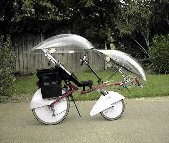 |

|
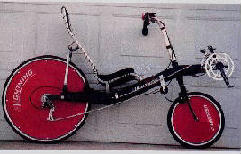
|
| |
||
|
I've about to over do these mouseovers.
javascript:history.back(1) Back to were you came from There seems to be fairly good evidence of global warming . Now one of the questions is it man made or is it natural . If It is man made what can we do about it ? I recycle , bicycle and have no children Will this do any good if many others do not recycle , drive everywhere and have many children? Can one person acting alone change the world? |
| Back to the top of the page just under the color box |
|
This link goes to a site http://www-eng.lbl.gov/osborn/cheetah/cheetah.html below is the first paragraph off the page The Dexter Hysol Cheetah is a fully faired semi-recumbent two wheeled Human Powered Vehicle (HPV). The Cheetah currently holds the world speed record for the 200 meter flying start event. This event allows a virtually unlimited run up to a 200 meter speed trap. Chris (The Punisher) Huber rode the Cheetah to an an average speed of 68.73 mph through the speed trap. The record was set at about 6:55 PM mountain standard time on September 22, 1992. The course was on Six Mile Lane which is a flat road which crosses a Bison preserve in the San Luis valley, Colorado. Of course, the Cheetah is named after the fast cat of the same name. |

|

|
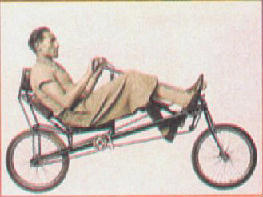 | ||
| A past record holder 68 mph | The 1933 bike that banded recumbents from UCI races |
Commercial version of the bike on the left |
| Back One JavaScript History. |
| Back to the beginning just below the color box |


|
A link to bottom of the page about Fairing In one sentence, Fairings can add speed. |
|
This is a magazine that I have not subscribed to for some time because I believed that it only told of the good or upbeat news or ideas and not the bad ideas or thoughts about recumbents. It was asking for information about Turner Laid Back bike (I owned one at the time) I sent in my opinion which was not compementary and there were no uncomplementary remarks in the article even though some of what I wrote in was. If you are looking to buy a bent it is worth the subscription if just for the year end buyer guide |
 A link to http://www.easyracers.com A link to http://www.easyracers.com
They have two styles the LWB OSS bike below in Steel, Aluminum, and Titanium and a CLWB to the right that I've heard goes for about $500 |
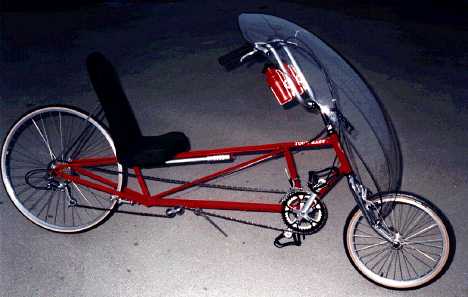
|
LWB Long Wheel Base
LWB bikes have 20Ē wheel in front of the pedals and 26Ē or larger rear tire behind the rider.
 The idea
behind recumbents is to lower wind resistance by lowering the frontal area. LWB bikes are better able to do
this than SWB or MWB bikes because the rider isnít sitting over the front tire. This does add weight and on
bicycles built for speed weight is a hindrance and the longer the wheel base the larger the turning radius but
the advantage is lower profile and therefore lower wind resistance helping to increase speed. Less weight on the smaller front wheel helps reduce rolling resistance. The first bike to go over 65mph through a 200 yard time trap was the long wheel base recumbent in the left mouseover The idea
behind recumbents is to lower wind resistance by lowering the frontal area. LWB bikes are better able to do
this than SWB or MWB bikes because the rider isnít sitting over the front tire. This does add weight and on
bicycles built for speed weight is a hindrance and the longer the wheel base the larger the turning radius but
the advantage is lower profile and therefore lower wind resistance helping to increase speed. Less weight on the smaller front wheel helps reduce rolling resistance. The first bike to go over 65mph through a 200 yard time trap was the long wheel base recumbent in the left mouseover
|
 |
 |

|
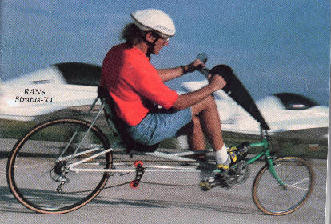
|
||
| Tour Easy hard seat | VISION R40 LWB ASS sling seat | RYAN LWB USS Mesh seat | RANS LWB OSS Mesh seat |
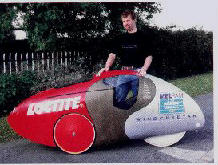
|

|
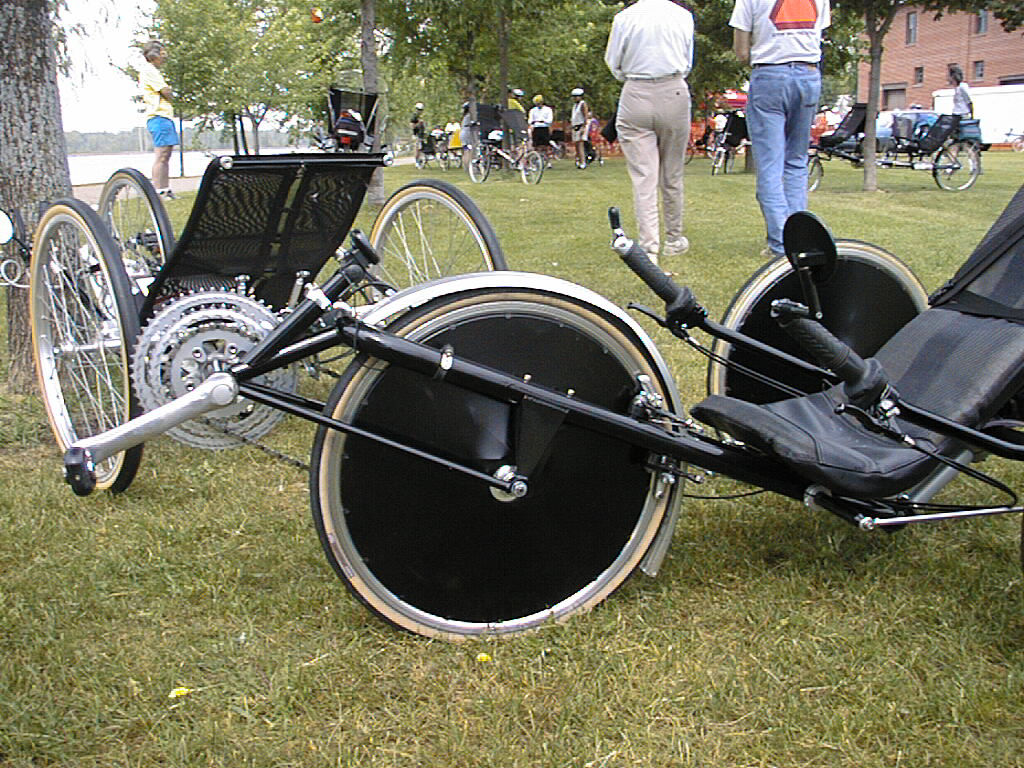
|
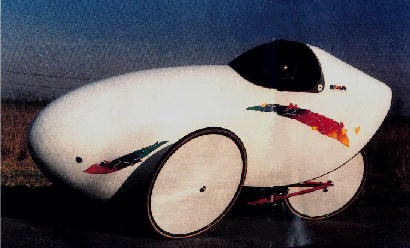
|
| These links are to the descriptions of recumbents at the beginning of the page |
| SWB | Short Wheel Base bike |
| MWB | Medium Wheel Base bike |
| CLWB | Compact Long Wheel Base bike |
| LWB | Long Wheel Base bike |
| Bent | Slang for recumbent |
| Tail Cone / Tail Box | This is a rear fairing very often seen in European bikes often used for extra storage but made for improved aerodynamics |
| CoroPlast© | This is a corrugated plastic - a plastic cardboard used in a lot of home made fairings |
| X-Seam | This is one way of measuring the length of a persons leg to tell if their leg is long enough • It is done by sitting with your back flat against a wall and measuring from the wall to the heel of your foot |
| Intermediate gear | Some people call this a jack shaft. It is or they are a set of gears ,typically a freewheel with the “paws” removed, that split the long recumbent chain into two chains. one from the front to the middle and from the middle to the rear. Two reasons • partially lessen the very long chain and its effects like shifting by itself in hard turns • and provide more gears higher and lower gears |
| Heel Interference | On short wheelbase bikes your heel of your foot can hit the front wheel when pedaling this is what they mean by heel interference. This happens at slow speeds when you are more likely to turn the front wheel more. After getting up to speed very little turning of the front is needed to turn the bike a lot |
| Chain Tensioner | Like on a mountain bike and usually made commercially for mountain bikes it is used to take up some of the slack of the long chain |
| Body Stocking | Usual cloth but not always • “cover that encloses the rider leaving just the head exposed for better aerodynamics” |
| DF | Diamond Frame bikes are conventional bikes so named for the many triangles that make up the old frames |
| HPV | Human Powered Vehicle this is anything that is powered by a human from bikes, or boats, to skates, or skis |
| ASS / OSS | Above or Over The Seat Steering Self explanatory the handle bar is located above the seat generally at chest level. |
| USS | Under the Seat Steering Self explanatory again. The handle bar is located Under the seat. |
| Mesh Seat | Is a seat that is more like a lawn chair in that it has a sling/mesh seat as opposed to a hard seat with cushions |
| Hard Seat | These are generally a fiberglass seat with some foam pad |
|
This will open your E-mailer for you to write a note to me Smile@hotmail Please be kind in that I am an amateur but if you really don't like something let me know. This is a learning experience for me and all you comments will be considered. |
|
I hope that this is of some value Please go through the rest of the this web site for more information about their problems etcetera. Send Comments good or bad on what you like or don't and how I can improve it.  | ||
|
Back 1 top
| |
|
This is by no means a definitive list of all that could be considered wrong with recumbents but a list that I have made to validate my own position as someone who experiments with and is open to discussion on some of the benefits and faults of these machines. It has been my experience that recumbents are slower than a diamond frame bike. This could be because they are heavier or due to the seating position. On a DF bike you can easily use your weight and at least some upper body strength to help move you and the bike. I am not able to put as much power into the pedals due to the seating position. All the power that I can put in is energy from my legs and not from my weight or upper body. Some people say that the recumbent rider can push against the seat to get more power but this is not as easy as it sounds and it takes more energy in my opinion because you are providing the energy and there is no gravity assistance involved. The speed records most people use to justify recumbents have generally been made with fully faired recumbents. It should be said here that the recumbent that got them banded from racing was an unfaired MWB bike so there is at least some truth to the idea that they are potentially faster. I have and ride exclusively a ATP Vision R40 that I made a fairing for. It is my only means of personal transportation so I put hundreds of miles a month riding it but I am always pasted by riders on Diamond Frame bikes. It should be noted here that those riders have said that they were not able to draft behind me or that the "wake" behind me was minimal. This "wake" is part of the drag that slows a rider down so maybe I can keep up with them or stay ahead longer because of the fairing and the bike but over all my average speed is 14.O mph (23.3 kph). From what I gather their average speeds range from 18mph (30kph) to 24mph (40kph). This is their stated averages not their top speeds. The faster riders often sprint to over 30mph (50kph) ,which is hard almost impossible for me to match drafting behind them, and going up hills they all leave me behind, I slow down to 7-12mph (13-20kph) while they may slow to 12-18mph (20-30kph). For me the fairing was put on for weather protection first and speed second. Recumbent riders are far more likely to add a fairing and fairings have a long history of helping increase speed. Fairings where first added to bikes to add speed before world war 1 and were band after a serious accident a few years later. I would like to see some races between fully faired diamond frame bikes against fully faired recumbents to see how they would match up. DF bikes would not have lasted as long as they have if there was not some advantage to them. The triangle is one of the strongest geometric forms. This makes for a light and strong base on which to construct a HPV. Your basic bike uses this triangle to its maximum benefit. In the end it is the engine (rider/s) that propel the vehicle and it is their strength and speed (cadence) that determines how fast an HPV will go. Fairings and light bikes help but a strong rider on a heavy bike with no aero dynamics can still beat a weak rider on a light bike with lots of aero dynamics advantages. If sweating totally disagrees with you these bike are not for you. Because the rider is sitting their back is against the seat and therefore does not have air circulating around it to help evaporate the sweat. For me this leads to a sweaty spot on the back and seat a great deal more so than on a diamond frame bike where my back is not pressed against the back of the seat.
Recumbents are at a definite disadvantage when going up hills. That does not mean they can't just that it is harder because
In My Humble Opinion when you are on the road with cars you in a dangerous potentially life
threatening situation
These are not the only accidents that I've been in but they and others have given me the experience to say that if you ride on the road enough you are likely to be hit by a car and no matter what you do to make your self visible they will say that they didn't see you . In the many years of riding I've had he misfortune to know two others who were not as fortunate as me and lost their lives while ride their bikes . Both of them rode DF bikes one religiously wore a helmet. I did not know these people well they just rode along the same route as I and therefore had an opportunity to talk. One rode for
environmental reasons the other for his health. | |
 This is a short history of recumbents or why they are not popular today told by www.bikefix.co.uk
This is a short history of recumbents or why they are not popular today told by www.bikefix.co.uk
The bike here is the first picture on that there and the page describes a short period of time in the 1930's and one manufacturer. |
|
HPV stands for human powered vehicle and in the broadest sense could encompass everything from the Oxford and Cambridge Boat Race to the human-powered aeroplane, Gossamer Albatross. In this booklet we are sticking to HPVs with wheels - although even this has problems. The most obvious of HPVs, the bicycle, is generally not allowed to compete in HPV events unless modified with some sort of fairing. "So my vehicle must have a body shell", you say. No, many of the entries do compete without any fairings at all |
 I have not visited this page recently but it is about how this bike was eventually banded from UCI races because it was considered an unfair advantage.
I have not visited this page recently but it is about how this bike was eventually banded from UCI races because it was considered an unfair advantage.
http://www.physics.helsinki.fi/~tlinden/winforb.html |
| Back 1
top |
| For a far more in depth version visit
The History of the Recumbent Bicycle ,
Winning forbidden: A history of recumbents,
or What is an HPV ?. These are just a few and focus on the forbidding of bents in races (one bike in particular) but bents have been around since the 1900's and never very popular it seems |
|
|
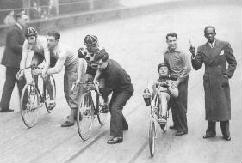
 A bicycle revival in the 30ís saw a lot of recumbents.
One maker noticed that his recumbent was significantly faster than conventional bikes and in 1933 asked the UCI if the bike fit their rules.
They referred to their earlier ruling of no aerodynamic devices but made no ruling. The bike later that year broke the prestigious 1 hour record and was beating all challengers .It set records that were not matched on conventional Diamond Frame bikes until the 60's .By 1934 the UCI had ruled against recumbents and set the strict dimensions on the bike .Their argument was that it should be a race of people and not machines. As far as the UCI (Union of Cyclist International) and
USCF (United States Cycling Federation)- The people that organize most professional races are concerned recumbents are illegal and banned from racing.
A bicycle revival in the 30ís saw a lot of recumbents.
One maker noticed that his recumbent was significantly faster than conventional bikes and in 1933 asked the UCI if the bike fit their rules.
They referred to their earlier ruling of no aerodynamic devices but made no ruling. The bike later that year broke the prestigious 1 hour record and was beating all challengers .It set records that were not matched on conventional Diamond Frame bikes until the 60's .By 1934 the UCI had ruled against recumbents and set the strict dimensions on the bike .Their argument was that it should be a race of people and not machines. As far as the UCI (Union of Cyclist International) and
USCF (United States Cycling Federation)- The people that organize most professional races are concerned recumbents are illegal and banned from racing.
In the 70ís interest in how fast a person could move under there own power was reborn. Dupont put up a prize of money for the first person to go over 65mph(93.3 feet per second)(109kph 30.3 meters per second) through a 200 yard? "time trap" on level ground with no wind.
|
| For the mouse overs to work I need <a href=" "> and that is a designation. The destination can be this page or it can go somewhere else. this links to the bike makers web page http://www.easyracers.com. This is the first bike to go over 65MPH ( 105KPH ) in 1985. The mouse0ver is a picture of that bike. |
| The International Human Powered Vehicle Association is a group of people that organize and sanction events for planes, trains, bikes, boats, and sometimes submarines. There sites are lists of many other HPV sites and interests. |
 Easyracers won this prize in 1985.It is this interest that led to proof that 80% of a persons energy was going to
move the air out of the way at speeds over 15 to 20 mph . This developed into the
International Human
Powered Vehicle Association an organization developed to record and encourage speed records on all
types of vehicles . This organization holds annual speed championships around the world and is at least partly
responsible for the resurgence of recumbents. There is now a prize for the first person to travel 45 miles in 1 hour.
Easyracers won this prize in 1985.It is this interest that led to proof that 80% of a persons energy was going to
move the air out of the way at speeds over 15 to 20 mph . This developed into the
International Human
Powered Vehicle Association an organization developed to record and encourage speed records on all
types of vehicles . This organization holds annual speed championships around the world and is at least partly
responsible for the resurgence of recumbents. There is now a prize for the first person to travel 45 miles in 1 hour.
A link to a Lexan&#trade; fairing maker. These are the clear fairings on some of the pictures like these
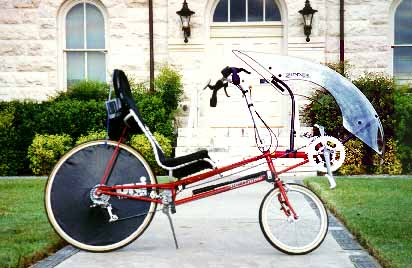

|
back
top
Fairings.htm |
|
This section will eventually be about fairings. How I have made mine. How I think others have made theirs. Where I think your best effort should be put and lots of pictures of mine and other peoples fairings. Below are some pictures of fairings that I've gathered. #1-5 are of my past and present bikes. I only have one bike now and that is #5 which is also #4 but the fairing in #5 I've made and those in #4 are Zipper fairings. The one on the front of the bike is commercial the one on top is my own idea. #1-3 are the same bike with different fairings on it, the bike was in an accident its replacement that was made in school shop was stolen! I have learned though reading and personal experience that the rear fairing is more important than the front fairing as far as speed is concerned. The rear is were the drag is created. It is because of this that many commercial recumbents in Europe have rear fairings "tail cones?" that add lockable storage and speed. #6 & 7 are examples of that. It has also been my experience that high good presure tires make a big difference. |
#1

|
#2
 |
||
#3
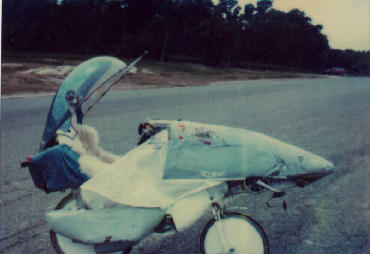
|
#4
 | ||
#5
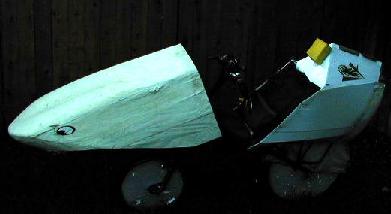
|
#6

|
||
#7
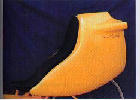
|
#8

|
||
#9

|
#10
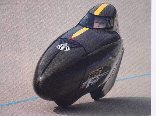
|
The above are the few pictures I have of my bikes. The #4 & #5 pictures are of the bike I now own and use as primary Transportation a Vision R40 by Alterative Transportation ATP. The ones before that, 1-3, are from a bike company that has gone out of business. That bike was stolen from me. It was heaver yet faster because it had an intermediate gear cluster that gave it a gear range of 20 gear
| A link to http://www.bikeroute.com/vr-4.html I don't check the links as often as I should and some time they change Please notify me of broken links. These 4 bikes are the same bike . That is one bike can be any of these four ; a LWB OSS or LWB USS or a SWB OSS or a SWB USS | |
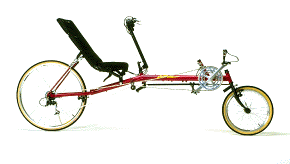
|

|
 |

|
The bike in picture #1 was one of my first attempts and the basis of the way I made the next three fairings and influence in the last one #4. It was made using coroplast as the backbone and what held it away from me and to the bike. In 1-3 the fairing itself was made from styrofoam blocks that were glued together and then sanded to the shape I wanted. After the shaped the styrofoam was covered with model airplane covering like monocoat. The fairing in #4 used the support from the zipper fairing to hold the fairing. The majority of the fairing is made with coroplast with a little styrofoam for shape and then covered with model airplane covering to make it uniform color. The first three cost about $30-50 dollars in materials # 4 because it uses a zipper fairing support cost considerably more but the fairing itself ( what you see in the picture ) cost about $30-$50.
You may be asking yourself if I already had a very nice commercial fairing why did I make one? The reason was because my bike is my primary form of transportation and I wanted to be able to ride in the rain and the commercial one was just not adaptable to that end. Though not pictured here yet #4 has been able to do just that.
Below are a few of the many great site describing various fairings the best in this list is the WISIL site which is a link to other sites on various recumbent type things . If you have not visited it yet it is a must see if these things interest you.
These Links are all here to help you look for information about making fairings. I have take a better look before I start editing but I believe that this is about how to make a coroplast fairing like
|
These have not been rated yet These Links are all here to help you look for information about making fairings. Maybe not like this one but they say you get out what you put in. I hope you get more out than you put in.
|
This page has some pictures of the fairing while under construction and has some advice that I hope someone finds useful. This Is A web page about How someone made a fairing with
coroplast and PVC pipe for their M5. The site has a fair amount of pictures on various stages of construction.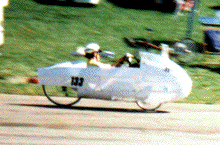
|
|
These Links are all here to help you look for information about making fairings. I have take a better look before I start editing but I believe that this is about how to make a coroplast fairing like The link in this box will take you to http://www.wisil.recumbents.com/wisil/whatsup.htm 

|
The wheel covers that I have experience with are the UNI ? wheel covers that have an aluminum hoop that a cloth cover is stretched and tightened over and the ones that I now have on my bike made from balsa wood hoops and monocoat ,a model airplane covering.
With the covers with aluminum hoops the hoops are attached to the wheel with clips after the cover is stretched over them . In my experience the hoop had a tendency to jump off the clips if a big bump in the road was hit . This more than once became a big annoyance.
The wheel covers on my bike now are home made using 1/8" balsa wood sections carved in the shape of the rim that they are going on then glued together overlapping the sections to form the hoop .One hoop each side each side glued to the other side with the scapes of balsa left over from caving the shapes needed for the hoops . The hoops are more than one layer of balsa glued together
overlapping so that the grain of the wood goes in a different direction than the layer its glued to. After the hoops were glued together and dry I glue the two opposing "hoops together through the spokes with scrape pieces of balsa ironed on the monocoat and
shrank it tight. The picture gives you a little idea of how it is done. I've had less trouble with these than with the ones with the aluminum hoops. Not that I have not had trouble with these but with these the balsa wood has never left the wheel and when the
monocoat separated from the balsa I could easily take it completely off.
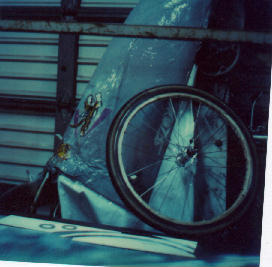 I hope that the picture has some value. One Balsawood "rim strip" is on the wheel and part of the other side can be seen in front cut out of the 3x12x1/8 balsawood. There are
a lot of small arcs that are glued together to make the whole circle that the model airplane covering will be ironed to. The short strips were cut using the rim as a template.
This Image is old but I hope that you can see what I have done.
The balsa that I will use to iron the model airplane covering to is in front with one small portion cut out of a 3x12x1/8 piece of balsa. This is tedious and so is gluing the pieces together to make the "rim" that the Monocoat® is ironed to but for me it has worked out nicely. After cutting small arcs the arc are glued together ,making sure to get cross grain overlap for added strength, the finished "rim-hoops" are glued to each other and on to the wheel with pieces of balsa wood between the spokes. After the "rims-hoops" are glued to each other and the wheel it will not be possible to true the wheel using a spoke wrench. The advantage I have seen with these over the UNI wheel covers is that the UNI covers had aluminum hoops that the cover was stretched over and then hooks attached to the spokes held the covers on. Some times when I hit a bump the cover would unhook and mangle the alumium hoop. this would require me to completly remove the hoop which ment removing the wheel and possibly the sprockets/freewheel. On the ones that I made the cover never jumps loose and if it is badly damaged and the cover portion has to be remove it is just ripped off. On that note monocoat® is easily damaged and the monocoat will last about a year (for me 6-9000 miles) before it is so trashed that it has to be replaced. When it has to be replaced the wheel does need to come off. Another advantage that I like is that the cover is more "inline" with the rim making a smoother transition
I hope that the picture has some value. One Balsawood "rim strip" is on the wheel and part of the other side can be seen in front cut out of the 3x12x1/8 balsawood. There are
a lot of small arcs that are glued together to make the whole circle that the model airplane covering will be ironed to. The short strips were cut using the rim as a template.
This Image is old but I hope that you can see what I have done.
The balsa that I will use to iron the model airplane covering to is in front with one small portion cut out of a 3x12x1/8 piece of balsa. This is tedious and so is gluing the pieces together to make the "rim" that the Monocoat® is ironed to but for me it has worked out nicely. After cutting small arcs the arc are glued together ,making sure to get cross grain overlap for added strength, the finished "rim-hoops" are glued to each other and on to the wheel with pieces of balsa wood between the spokes. After the "rims-hoops" are glued to each other and the wheel it will not be possible to true the wheel using a spoke wrench. The advantage I have seen with these over the UNI wheel covers is that the UNI covers had aluminum hoops that the cover was stretched over and then hooks attached to the spokes held the covers on. Some times when I hit a bump the cover would unhook and mangle the alumium hoop. this would require me to completly remove the hoop which ment removing the wheel and possibly the sprockets/freewheel. On the ones that I made the cover never jumps loose and if it is badly damaged and the cover portion has to be remove it is just ripped off. On that note monocoat® is easily damaged and the monocoat will last about a year (for me 6-9000 miles) before it is so trashed that it has to be replaced. When it has to be replaced the wheel does need to come off. Another advantage that I like is that the cover is more "inline" with the rim making a smoother transition
Here is a link to someone who just glued/ironed the monocoat® to the rim for their wheel cover These links should also be in the pull down list and in the menu page. There are problems with everything and this is no exception . these balsa hoops after they are glued together on the wheel they can not be easily removed and placed on another wheel unlike "UNI" wheel covers with the aluminum hoops and clips. Those wheel covers can easily be removed except at the sprockets were you need to remove the freewheel/ to remove the wheel cover. I have been pleased with the home made covers that I've made. I've heard of others that instead of making balsa wood hoops like I did they just glued the model air plane covering directly to the rim of the wheel. If this is done the brakes must be very carefully adjusted so that they don't come in contact with the cover or they will rip it off when the brakes are applied. |
Someone in the Wisconsin Illinois areas or at least on their WISIL site has made a far better wheel cover than mine will ever
be. These are a few pictures to give you an idea of what they have done. 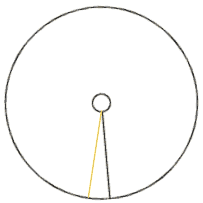
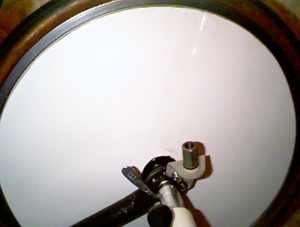

If you have ever thought of making wheel covers this is a must see site. The covers are make with thin plastic that is cut to form a cone. The 'slot' that makes the circle a cone is taped with clear packing tape. A fastener is also made with plastic or thin metal then Velcro is attached to it and the cover to hold the cover on. |
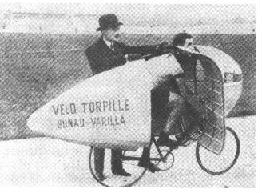 I have to start by saying that good high presure tires are probably the best investment for the time and money to increase your speed and that a fairing is probably one of the last things you should add for speed. But after all else is done fairings are what really make recumbent bikes and bikes in general go fast The real speed advantage is gained with the rear fairing because it is the
turbulence in the back that add the drag on the bike
This has been known for quite some time but modern race rules are about races between people and not machines. There are only a few commercial bikes that I know that have fairings as bike specific
options, the F40 by
Lighting the
kingcycle and the interceptor by
Rotator The F40 is a lighting P38 with a
Zipper type fairing and cloth body .The Kingcycle is fiberglass front and rear with the rear fairing being lockable .
I have to start by saying that good high presure tires are probably the best investment for the time and money to increase your speed and that a fairing is probably one of the last things you should add for speed. But after all else is done fairings are what really make recumbent bikes and bikes in general go fast The real speed advantage is gained with the rear fairing because it is the
turbulence in the back that add the drag on the bike
This has been known for quite some time but modern race rules are about races between people and not machines. There are only a few commercial bikes that I know that have fairings as bike specific
options, the F40 by
Lighting the
kingcycle and the interceptor by
Rotator The F40 is a lighting P38 with a
Zipper type fairing and cloth body .The Kingcycle is fiberglass front and rear with the rear fairing being lockable .
| ||||||
| ||||||
I have made a few fairings for my bikes . The best so far was this
 The Shark
It was made out of coroplast, a corrugated plastic ,styrofoam and monocoat, a model airplane covering. I called it the lead sled everyone else called it the
Shark. It was in an accident and its replacement that I made in the college metals shop was
stolen! Both were very fast bikes I believe because they had an intermediate gear that gave then an
extremely wide range of gears. The Shark
It was made out of coroplast, a corrugated plastic ,styrofoam and monocoat, a model airplane covering. I called it the lead sled everyone else called it the
Shark. It was in an accident and its replacement that I made in the college metals shop was
stolen! Both were very fast bikes I believe because they had an intermediate gear that gave then an
extremely wide range of gears.
Now I have a Vision R40 with a Zipper fairing That I know is not as fast or even close to as fast as the previous bike. I plan to make a new fairing for the front but I must emphasize that it is the rear fairing that will gain you the most speed. Wheelcovers are the best advantage, outside of good tires, for weight / cost / time as far as my experience shows. I gained 2.5 MPH average speed with the addition of the wheel covers . The "fairing" over the front wheel is really a fender/mudguard and does not help with speed IMHO . It was made with aluminum flashing shaped and taped together . Then taped to the front forks and covered with monocote. I've made others that were made out of coroplast, styrofoam and monocoat that carried a light . These add a certain look to the bike like fairings in general but I don't believe that they add any speed advantage. They are neat mudguards though. The rear fairing/fender/mudguard was made out of a commercial bike mudguard with balsa wood strips glued to it to hold the monocoat in place I have hade marginally good results with Styrofoam blocks that can easily be carved and sanded to the shape that I desired. These blocks were first glued to something ,generally coroplast, then shaped. After I was satisfied with the shape it was covered with model airplane covering ,monocoat or similar. A great deal of care must be taken when applying the monocoat because the styrofoam melts easily . You could instead of monocoat use a fiberglass type covering but again styrofoam melts easily and the right epoxy is necessary. |
 For those of you in Sacramento Here is were I purchased my recumbent A Vision R40. It was at the "Bike Shop" on the corner of San Jaun and Winding Way behind the Dairy Queen. At 4719 San
Juan at the red arrow on the map. Phone # 961-9646 open 7 days a week Sunday noon till 4 M-F 10-6 Saturns day 10-5 ?. Go to
MapQuest to get directions to there from where ever you are.
For those of you in Sacramento Here is were I purchased my recumbent A Vision R40. It was at the "Bike Shop" on the corner of San Jaun and Winding Way behind the Dairy Queen. At 4719 San
Juan at the red arrow on the map. Phone # 961-9646 open 7 days a week Sunday noon till 4 M-F 10-6 Saturns day 10-5 ?. Go to
MapQuest to get directions to there from where ever you are.
|
| I find more spelling errors every time I open the page but no one has E-Mailed me about any. Ofcouse with less than 2000 unique visitors I suspect that most of you do not notice or care and if you see an error you are not going to spend the time telling me about it. |
| a link to
Is a racing recumbent really faster than an aero time trial bike or a quality road bike? Cycling Plus coach Joe Beer used the SRM Power Cranks to find out.
No mention of the tires or tire presure in the article. Good tires make alot of difference |
|
| Color box is under the top tan box. If it is not visible move your mouse over and off the box
The box is just some rather worthless JavaScript to change the color of items on the page like the background color , the text color or to separate the visited links (Those on this page or that you have seen already)from the links not yet visited |
|
Black and gray fits my personality
and provided a good enough contrast for easy reading but you can change the colors to something more to your liking )
|
|
gray fits my personality
but you can change the color to something more to your liking )
|
|
A link to farther down this page on why I think recumbents are slower up hills. Recumbents are at a
definite disadvantage when going up hills because they are heavier, their seating position does not lend its self to using a persons weight or their upper
body strength. |
|
A link to below Very Short History ! Fairings and recumbents have an old past. Fairings have been band from races since about 1914/15 and recumbents since 1934/5 because they were considered an unfair advantage .
|
|
This link is to an off page site of Steve Robson experiences with mountain bikes, road bikes, LWB,SWB,& CLWB recumbents
There strengths and weak points of their designs from his point of view. The five different types are being compared on the following items, Overall handling on varied surfaces, Transportability on cars, Overall safety in varying traffic conditions, Overall design layout, and Comfort on the bike on long trips |
| a link to sandiway@research.nj.nec.com Last updated: 07/05/2000 08:15:46
One question I've recently become interested in is whether unfaired recumbents are generally faster or slower than road bikes equipped with
aero bars. |
|
Recumbents are those sit down feet first bikes. Here are three pictures of bents a Short Wheel Base SWB, a Compact Long Wheel Base CLWB, and a Long Wheel Base LWB 
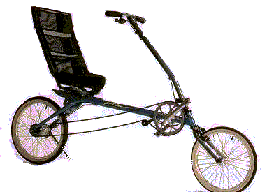

|
| It is a small gallery (about 40 pictures) that I have not worked on almost from the start. The pictures are small about 3”wide & 1.5” tall and anywhere from 6kb to 36kb in size and some of the pictures are on this page. I know of some errors on that page that I have not corrected yet and I am not sure how or want I want to do about the page. |
|
My whole page has numerous
JavaScript items. The colors at the top of my page gives you the ability to change the color of the links, the visited links, the background color, and the text color. It is there so that you can make the page more pleasing to
your eyes and separate the visited links like those on this page or that you have already seen from the links not visited yet
Click anywhere in this box or on the link to hide the box if it distracts you I liked Gray when I first made the page because of the low glare but now when I visit my page I change the colors to 002500 text and dark tan background or dark blue text and black background |
|
| |
|
| |
|
There are too many times when I saved a web page and failed to get some link or something from it and then after discovering my error could not find my way back.
This is my way of trying to correct that. If you have saved this page with the pull down menu you have 90% of my page. But not the links from this page. There are over 20 links on this page and over a hundred in the pull down list. If you plan to save this to your favorites to view off line it would not be advisable to save even one link deep because of the number of links. With one link deep there are well over a hundred pages and growing that this page links to and by two links it could very quickly go over a thousand pages and maybe over 10,000 by the third link deep.
Save this page only! At that point you are missing the plain html menu and a small picture gallery Click anywhere in the box to go back there if you want and if it is still there. It will be there until 06/06/01 when I have to decide whether to renew or not That will depend partly on if I have any E-mail requesting it to stay. |
|
|
This will open your E-Mail Program so you can send me a note at Smmile@hotmail.com or you can go to the bottom of the page and fill in a survey
Tell me what you think with no regard to my feelings. If you see spelling or grammar errors please let me know where they are. If you do not like something please let me know. If you believe that I have misrepresented any information or not given a good true picture of things please let me know. If you just hate this page tell me why! If you do not like bikes tell me how to get around without spending a lot of money, cars are expensive to own and operate. What do you think of the mouse over pop up boxes? or the pull down menu? or the colors box Should I add more links in the pull down? I have thought of adding many that I have seen in other lists from the lists of lists. What do you think of the menu frame? Do you read the comments in the second box ? Do you even use the menu? Would you tell someone else about this page? Writing a page takes a lot of time and I am an amateur. . I have until 6/6/01 to decide if I want to renew. I have not gotten much of any real responce as to what you out there think of this page. One person early on said they liked the color changer on the top and one person said that they visited but had no comments a third person hated the site. The poll numbers are improving about 50% fo you think that it is a great page 30% ok 10% are not sure 10% hate it. I know there are some spelling errors, they are hard for me to find in notepad. If you want to tell me of the spelling errors please tell me where you saw them and not just that you saw some spelling or grammar errors |
-- I would rather do this than home work or many other things that I could profit from
I am both. I have had this page for just about a year and even though it may look like I know something I really do not |
| Due to the screwed up laws in this country (A person falls off a bike and hurts themselves. The bike did not fail in any way yet the manufacturer was sued out of business) This is my disclaimer. You will die some day and it is not my fault! Riding a bicycle is inherintly dangerous about 9000 people are killed every year in bike/car accidents <DOT> These pictures are gathered half through magazines and books that I have and the other half through the Internet. I am claiming as a means of defense from copyright suits the idea of fair use in that no profit is made from this site and that it is meant to educate the general public through my experiences and knowledge of the subject of Human Powered Vehicles(recumbents bikes for now) on this Planet commonly referred to as Earth. If you know the owners of these pictures and want to tell them were I am go ahead I will give credit or remove the pictures if asked. |
|
if you wish to join then E-mail Sam at Sam@betalink.net.au [HPV Boardroom] [Host page][List sites in ring] |
|---|